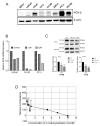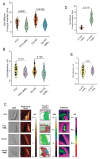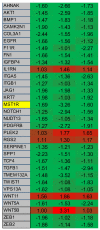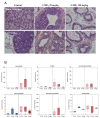Evidence for 2-Methoxyestradiol-Mediated Inhibition of Receptor Tyrosine Kinase RON in the Management of Prostate Cancer
- PMID: 33673346
- PMCID: PMC7918140
- DOI: 10.3390/ijms22041852
Evidence for 2-Methoxyestradiol-Mediated Inhibition of Receptor Tyrosine Kinase RON in the Management of Prostate Cancer
Abstract
2-Methoxyestradiol (2-ME2) possesses anti-tumorigenic activities in multiple tumor models with acceptable tolerability profile in humans. Incomplete understanding of the mechanism has hindered its development as an anti-tumorigenic compound. We have identified for the first-time macrophage stimulatory protein 1 receptor (MST1R) as a potential target of 2-ME2 in prostate cancer cells. Human tissue validation studies show that MST1R (a.k.a RON) protein levels are significantly elevated in prostate cancer tissues compared to adjacent normal/benign glands. Serum levels of macrophage stimulatory protein (MSP), a ligand for RON, is not only associated with the risk of disease recurrence, but also significantly elevated in samples from African American patients. 2-ME2 treatment inhibited mechanical properties such as adhesion and elasticity that are associated with epithelial mesenchymal transition by downregulating mRNA expression and protein levels of MST1R in prostate cancer cell lines. Intervention with 2-ME2 significantly reduced tumor burden in mice. Notably, global metabolomic profiling studies identified significantly higher circulating levels of bile acids in castrated animals that were decreased with 2-ME2 intervention. In summary, findings presented in this manuscript identified MSP as a potential marker for predicting biochemical recurrence and suggest repurposing 2-ME2 to target RON signaling may be a potential therapeutic modality for prostate cancer.
Keywords: 2-methoxyestradiol; RON; atomic force microscopy; bile acids; castration-resistant prostate cancer; epithelial mesenchymal transition; mechanical properties; prostate cancer disparities; receptor tyrosine kinase.
Conflict of interest statement
Authors declare no conflicts of interest. The funders had no role in the design of the study; in the collection, analyses, or interpretation of data; in the writing of the manuscript, or in the decision to publish the results.
Figures





Similar articles
-
Involvement of FLIP in 2-methoxyestradiol-induced tumor regression in transgenic adenocarcinoma of mouse prostate model.Clin Cancer Res. 2009 Mar 1;15(5):1601-11. doi: 10.1158/1078-0432.CCR-08-1389. Epub 2009 Feb 17. Clin Cancer Res. 2009. PMID: 19223508 Free PMC article.
-
Crosstalk between RON and androgen receptor signaling in the development of castration resistant prostate cancer.Oncotarget. 2016 Mar 22;7(12):14048-63. doi: 10.18632/oncotarget.7287. Oncotarget. 2016. PMID: 26872377 Free PMC article.
-
Prostate Epithelial RON Signaling Promotes M2 Macrophage Activation to Drive Prostate Tumor Growth and Progression.Mol Cancer Res. 2020 Aug;18(8):1244-1254. doi: 10.1158/1541-7786.MCR-20-0060. Epub 2020 May 21. Mol Cancer Res. 2020. PMID: 32439702 Free PMC article.
-
The macrophage stimulating protein/Ron pathway as a potential therapeutic target to impede multiple mechanisms involved in breast cancer progression.Curr Drug Targets. 2010 Sep;11(9):1157-68. doi: 10.2174/138945010792006825. Curr Drug Targets. 2010. PMID: 20545605 Review.
-
The ron receptor tyrosine kinase: a key regulator of inflammation and cancer progression.Crit Rev Immunol. 2013;33(6):549-74. doi: 10.1615/critrevimmunol.2013007953. Crit Rev Immunol. 2013. PMID: 24266348 Review.
Cited by
-
Investigating causality and shared genetic architecture between body mass index and cognitive function: a genome-wide cross-trait analysis and bi-directional Mendelian randomization study.Front Aging Neurosci. 2024 Oct 16;16:1466799. doi: 10.3389/fnagi.2024.1466799. eCollection 2024. Front Aging Neurosci. 2024. PMID: 39478699 Free PMC article.
-
Development of an HPLC-FLD Method for Estradiol and Metabolites: Application of Solid-Phase Microextraction.Int J Mol Sci. 2025 Jun 27;26(13):6194. doi: 10.3390/ijms26136194. Int J Mol Sci. 2025. PMID: 40649972 Free PMC article.
-
Preparation of 2-Methoxyestradiol Self-emulsified Drug Delivery System and the Effect on Combination Therapy with Doxorubicin Against MCF-7/ADM Cells.AAPS PharmSciTech. 2022 May 18;23(5):147. doi: 10.1208/s12249-022-02298-6. AAPS PharmSciTech. 2022. PMID: 35585431
-
MST1R Gene Variants Predispose Individuals to Tetralogy of Fallot.Phenomics. 2025 Jan 21;4(6):548-561. doi: 10.1007/s43657-024-00175-9. eCollection 2024 Dec. Phenomics. 2025. PMID: 40061823 Free PMC article.
-
Oestrogen receptor-independent actions of oestrogen in cancer.Mol Biol Rep. 2023 Nov;50(11):9497-9509. doi: 10.1007/s11033-023-08793-8. Epub 2023 Sep 20. Mol Biol Rep. 2023. PMID: 37731028 Review.
References
-
- American Cancer Society . Cancer Facts & Figures 2020. American Cancer Society; Atlanta, GA, USA: 2020. pp. 1–76.
-
- Du Y., Shen J., Hsu J.L., Han Z., Hsu M.-C., Yang C.-C., Kuo H.-P., Wang Y.-N., Yamaguchi H., Miller S.A., et al. Syntaxin 6-mediated Golgi translocation plays an important role in nuclear functions of EGFR through microtubule-dependent trafficking. Oncogene. 2014;33:756–770. doi: 10.1038/onc.2013.1. - DOI - PMC - PubMed
MeSH terms
Substances
Grants and funding
LinkOut - more resources
Full Text Sources
Other Literature Sources
Medical
Molecular Biology Databases
Research Materials

